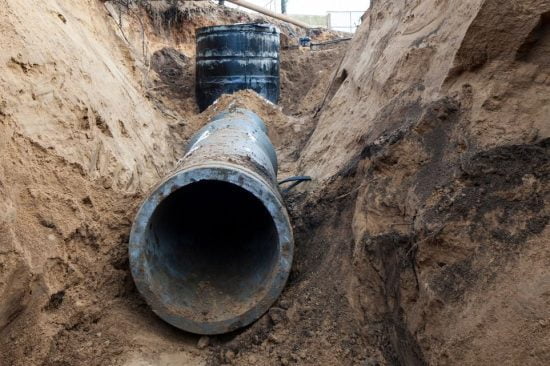One of the most essential components of any residential or commercial property is its sewer line system. Yet many property owners find themselves unprepared when things go wrong with this vital system. When dealing with sewer line replacement costs, many people often find themselves caught unaware of unexpected expenses that might occur.
We have put together an invaluable guide detailing all costs involved with replacing or repairing a sewer line for your convenience.
What is a Sewer Line?
A sewer line is an underground pipe used to transport wastewater from homes and office buildings to local treatment facilities for treatment. When properly functioning, its presence remains out of sight and out of mind; but any issues can lead to significant inconvenience and damages that must be repaired quickly and affordably.
Sewer line replacement involves removing and replacing old, cracked, or damaged sewer pipes. This process is essential when the existing sewer line is beyond repair or has reached the end of its service life.
Factors Influencing Sewer Line Replacement Cost

There are a few key elements to keep in mind when estimating the sewer line replacement price:
Location and Accessibility: When accessing sewer lines is easier, costs tend to decrease; conversely, if they’re buried deep beneath concrete slabs or driveways, costs increase significantly which will include the pipe, sand and gravel, labor, construction, and other factors
Length and Diameter of Line: Longer sewer lines or larger diameter lines will cost more to replace than their smaller counterparts.
Material of the Pipes: Older homes may utilize clay or cast iron pipes while newer properties often employ PVC. The choice of material will affect both its longevity and replacement costs. For the material of the sewer pipe ABS Plastic, PVC Plastic, and Cast Iron can be used based on the need and affordability.
Repair/Replace Method: Traditional excavation-based solutions will likely cost more than modern trenchless methods of repair/replacement.
Average Costs of Sewer Line Repair
Your sewer issues might only require minor repairs rather than a complete replacement, and here is an estimate of sewer line replacement cost:
Minor Repairs: Small leaks or cracks repair may cost between $50 and $500 to fix.
Pipe Relining: Placing a new liner inside an existing pipe can range between $70 and $250 per foot, depending on length and condition.
Spot Repair: For pipes that have only sustained minor damage, spot repairs may be an efficient and economical solution. They typically range in cost between $250 to $3,500, depending on the complexity of the job.
Sewer Line Replacement Cost Based On Different Methods
If repairs are no longer viable, the time has come to consider full sewer line replacement costs. Below are estimates based on different scenarios:
Traditional Replacement: With this approach, trench digging must be undertaken in order to access every length of pipe in question. Costs typically range between $50 and $250 per foot for this method – which means for 50-foot lines; it could cost anywhere between $2,500 to $12500 in labor alone!
Trenchless Replacement: This non-intrusive method uses cutting-edge technology to install new lines without the need to dig up your entire yard, with costs typically ranging from $60 per foot.
Additional Costs: Always account for unexpected costs such as landscaping, permits, and any possible fees from sewer or utility providers.
Preventative Measures for Sewer Clogs
Proper care of your sewer line can increase its longevity and decrease its replacement costs:
- Regular Inspections
Since sewer lines are laid beneath the ground, it may be easy to neglect them altogether. However, regular professional inspections with camera technology can provide invaluable early warning of cracks, blockages, or weaknesses in pipes which might become severe issues if left unnoticed. - Avoid Flushing Unsafe Items
Our drains aren’t garbage disposals; therefore, it is vitally important to remain mindful about what we flush down toilets or pour down sinks. Disposing of cooking grease might seem harmless at first glance, but as it cools, it solidifies into blockages that will require professional plumbing repair to resolve. Likewise, products labeled “flushable,” like certain wet wipes or products marked “flushable,” might not disintegrate as easily as toilet paper and cause obstructions in both cases. Educating family members – especially children – about only flushing appropriate items is key in order to avoid costly complications in future plumbing repairs. - Tree Maintenance
Trees may add beauty and value to your property, yet they can pose a silent danger to sewer lines. Their roots seek moisture in cracks in your sewer lines, eventually expanding and restricting flow or even breaking them entirely. Routine inspection of areas near large trees near sewer lines may reveal early indicators of root intrusion.
Final Thoughts
While the idea of facing a sewer line repair and replacement can be daunting, being informed about the potential costs and preventive measures can make the process more manageable. Hence, the average cost of sewer line replacement typically ranges from $500-$2000. By understanding the factors that influence the sewer line replacement cost and taking proactive steps to maintain your system, you can navigate this essential home repair with confidence. Remember, regular maintenance and inspection are key to avoiding unexpected costs and ensuring the longevity of your property’s plumbing system.
Experiencing blockages or damage in your sewer lines? Look no further than Roto-Rooter. As the leading plumbing experts in the United States, we pride ourselves on our proficiency and swift response. Call now!